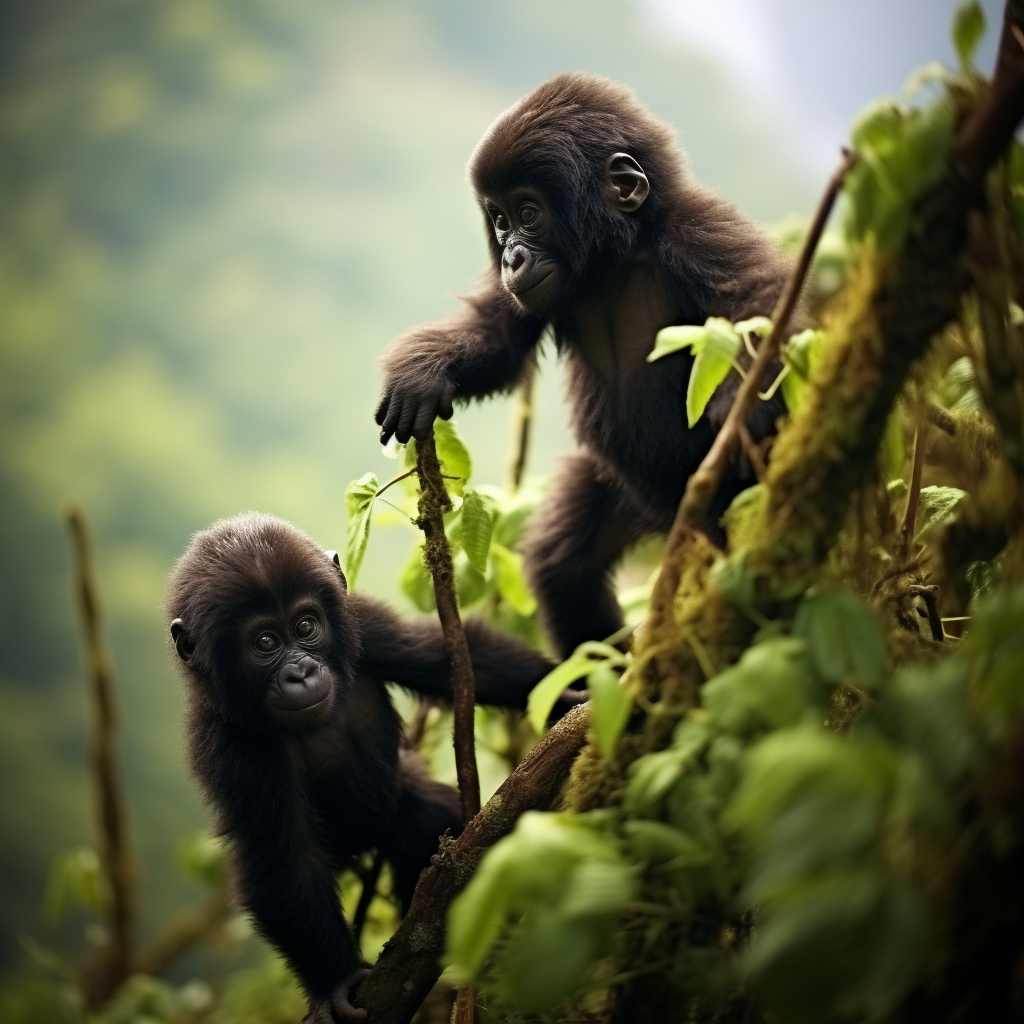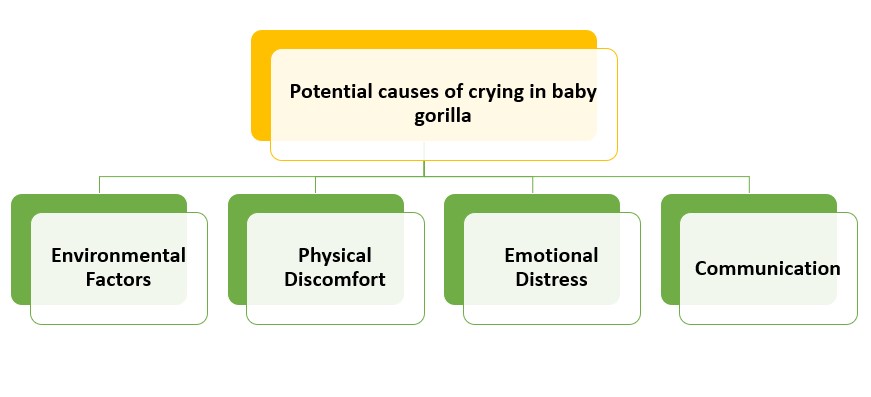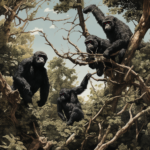.jpg)
Key Takeaways
- Baby gorillas do cry, just like human babies. This behavior is a way for them to communicate their needs and emotions to their mothers and other members of their group.
- Gorilla mothers are highly attentive and responsive to their babies’ cries. They will comfort and protect their young ones when they cry, just like human mothers do.
- Crying is an important part of the bonding process between baby gorillas and their mothers. It helps establish a strong emotional connection and fosters a sense of security and trust.
- Baby gorillas cry for various reasons, including hunger, discomfort, fear, or simply seeking attention and reassurance. Their cries can vary in intensity and duration depending on the situation.
- Crying is not limited to baby gorillas; adult gorillas also vocalize their emotions through various sounds, including grunts, roars, and barks. These vocalizations serve as a means of communication within the gorilla group.
- Understanding the crying behavior of baby gorillas can provide valuable insights into their social and emotional development. It can also help researchers and conservationists in their efforts to protect and conserve these endangered animals.
Do baby gorillas cry? Scientists and animal lovers have been asking this question for ages. Gorillas are known to be expressive, but do they really shed tears like humans? Let’s dive into this subject and explore the emotions of baby gorillas.
Baby gorillas need their mums for love and protection. They form strong bonds with them and other gorillas in the group. This is important for their emotional growth and survival. Baby gorillas have sounds and body language to express their feelings.
Although, there is no evidence that they cry with tears like humans. It’s thought they make these sounds to show they need attention and comfort.
So how can we help baby gorillas emotionally? We can create a natural environment where they can socialize, learn and be rewarded for good behavior. And by educating people about their emotions, we can encourage empathy and better conservation for these incredible animals.
Understanding Emotions in Animals
Animals, much like humans, experience a range of emotions. While it can be challenging to fully comprehend the depth of their feelings, research has shown that animals are capable of experiencing emotions such as joy, fear, sadness, and even love.
Through studies that observe behavior and physiological responses, scientists have gained insights into the emotions of various animal species. These observations have not only helped us understand the inner world of animals but have also deepened our appreciation for their complex emotional lives.
Expanding upon the earlier discussion, it is worth noting that animals’ emotional experiences are not limited to their immediate surroundings or interactions. They can react to both positive and negative events, displaying emotions that may seem familiar to us. For example, elephants have been observed mourning the loss of their loved ones, while primates like gorillas have displayed signs of happiness and affection towards their offspring. Such behaviors highlight the depth of emotions that animals can experience.
It is fascinating to observe the universality of emotions across species. By recognizing the emotional capacities of animals, we can develop a better understanding of their needs and promote their overall well-being.
Additionally, acknowledging the presence of emotions in animals challenges the notion that humans are the only beings capable of experiencing complex feelings. It reminds us of the shared emotional connections that exist between different species and deepens our sense of empathy towards the animal kingdom.
The Emotional Lives of Animals
Animals’ emotional lives are intriguing. Just like humans, they experience a variety of emotions that affect their behavior and how they interact with their environment. From joy to sorrow, animals display complex emotions that often mirror our own.
Signs of joy can be seen in their playfulness, wagging tails and relaxed body postures. Fear is exhibited through fleeing, freezing or hiding. Animals also show love and attachment towards their young and companions.
An exceptional aspect of animal emotions is their capacity to sympathize with others. Elephants, for instance, have been known to comfort those who are distressed by touching them with their trunks and making calming sounds. This reveals that animals understand and react to the feelings of others, not just their own.
It is essential to study animal emotions, not only for scientific reasons but also from an ethical standpoint. By acknowledging that animals have similar emotions to us, we can cultivate more kindness and sympathy towards them. This can lead to more thoughtful treatment and conservation efforts.
How Emotions are Expressed in Animals?
To really grasp emotions in animals, it’s important to observe their behavior closely. They communicate feelings through vocalizations, body language, and facial expressions. Researchers have gained useful knowledge from studying these cues.
Let’s explore some examples. Dogs wag their tails, bark, and lick when they’re happy or excited. Cats purr when content. Horses whinny and neigh to voice various feelings. Birds sing and chirp to express emotions.
Different species have unique ways of expressing emotions. For example, a dog may crouch down with its tail between its legs to show fear or submission. A cat may flatten its ears against its head when angry.
So, to understand how emotions are expressed in animals, pay attention to vocalizations, body language, and facial expressions. You may be surprised by the complexity of their feelings. Don’t miss out on these insightful glimpses into the animal world. And remember, primates may have degrees, but they can’t compete with the animal kingdom in reading minds and throwing poop!
Emotional Intelligence in Primates
Primates, including gorillas, exhibit emotional intelligence. They possess the ability to understand and express emotions, both verbally and non-verbally. This capacity for emotional intelligence allows primates to form strong social bonds, navigate complex social situations, and communicate effectively within their groups. Their emotional intelligence helps them recognize and respond to the emotions of others, leading to improved cooperation and social cohesion. It also plays a crucial role in their problem-solving abilities and decision-making processes. Emotionally intelligent primates can navigate various social dynamics with ease, showcasing their advanced cognitive abilities.
Moreover, primates display a wide range of emotional responses, including joy, sadness, fear, and anger. They can express their emotions through facial expressions, vocalizations, body language, and gestures. These expressions not only communicate their emotional state but also help establish and maintain social relationships within their communities. Additionally, primates can recognize and understand the emotions of other individuals, allowing them to respond appropriately and empathetically.
Research has revealed several unique details regarding emotional intelligence in primates. For example, studies have shown that primates are capable of empathy, displaying the ability to understand and share in the emotional experiences of others. This empathetic behavior leads to a higher level of social connectedness and cooperation within their groups.
One remarkable historical event showcasing emotional intelligence in primates is the case of an adult gorilla named Koko. Koko was known for her ability to learn and use sign language to communicate with humans. Through this form of communication, Koko could express a wide range of emotions, demonstrating her emotional intelligence. This groundbreaking case highlighted the depth of emotional capacity in primates and further exemplified their ability to understand and engage in complex social interactions.
Studies on Emotional Intelligence in Primates
Studies have been done to look into primate emotional intelligence. The experiments unearthed the cognitive and emotional abilities of primates. This gave us a better understanding of their social dynamics and behavior.
In one study, the primates showed complex emotions similar to humans. They showed empathy, compassion, and an understanding of the feelings of others in their group. This implies that primates have a kind of emotional intelligence that helps them form strong social bonds.
Another study looked into how primates cope with stress. It revealed that certain species of primates have built-in coping strategies like self-soothing or getting comfort from others. This shows they can handle stress and control their emotions.
Also, researchers saw signs of deception and manipulation. This indicates self-awareness and strategic thinking. This means primates can use emotional manipulation to get ahead in their social groups.
Therefore, the studies give us insight into primate behavior. By understanding their emotional capacities, we can develop a wider view of primate intelligence and use more humane approaches to conserve them.
Pro Tip: When studying primate behavior, it is important to consider both individual traits and species-specific traits to get the full range of their emotional intelligence.
Similarities between Human and Primate Emotional Responses
Humans and primates share striking emotional similarities – a comparison table reveals their joy, fear, anger, sadness, empathy, and social bonding. However, some primates may also possess self-awareness and self-consciousness, leading to complex emotions like guilt or shame.
This understanding can have practical implications. It promotes ethical treatment towards primates and can be applied to animal welfare and conservation efforts. Enrichment activities and protected areas that mimic natural social behaviors can also be created to ensure better care and protection for them.
The emotional complexity of primates brings us closer to understanding the broader spectrum of emotions experienced by all animals.
Baby Gorillas and Expressing Emotions

Baby gorillas, like humans, are capable of expressing various emotions. However, instead of shedding tears, their emotions are predominantly communicated through non-verbal cues. These include body language, facial expressions, and vocalizations. Just like human infants, baby gorillas use these means of communication to convey their needs, seek attention, and establish social bonds.
When a baby gorilla is happy or content, they may display playful behaviors such as somersaulting, jumping, and swinging from tree branches.
Their facial expressions may consist of relaxed and open mouth movements, which signify a sense of joy. On the other hand, when a baby gorilla is upset or frustrated, they may exhibit behaviors such as hitting the ground, pounding their chest, or displaying signs of agitation. These actions communicate their need for assistance or attention from their caretakers or fellow gorilla members.
It is important to note that baby gorillas, just like their adult counterparts, live in close-knit social groups where emotional bonds are crucial for their overall well-being. Therefore, the ability to express emotions is vital for the survival and development of baby gorillas within their social environment.
Vocalizations and Facial Expressions of Baby Gorillas
Baby gorillas communicate with a range of vocalizations and facial expressions. They use these to express their feelings.
Vocalizations from gentle grunts to loud roars carry distinct meanings. For example, joy, fear, anger, or distress.
Facial expressions like raised eyebrows, wide eyes, or open mouths show excitement, surprise, or warning.
Baby gorillas also use lip-smacking or tooth-grinding to indicate contentment or discomfort.
Body postures and gestures further enrich their communication.
Observe context and accompanying body language for a better understanding of their emotions.
Oh, and do baby gorillas cry? Only when they have bad hair days!
Do Baby Gorillas Cry?
Baby gorillas, like humans, cry. Crying is a way for them to communicate and express their needs and feelings. It sends a signal to their mother or caretaker that something is wrong or that attention is needed. This behavior is essential for survival and development.
Gorillas are social animals. Crying helps build strong bonds between mother and baby. It creates a sense of protection and care in the group. The emotional connection formed through crying encourages trust and safety among family members.
Moreover, baby gorillas cry for other reasons too – when scared or distressed. They use vocalizations during these times, to seek comfort from their mothers. Mothers respond with reassurance and physical contact.
Potential Reasons for Crying in Baby Gorillas

Potential Causes of Crying in Infant Gorillas:
- Environmental Factors: Baby gorillas may cry due to discomfort caused by extreme temperatures, loud noises, or unfamiliar surroundings.
- Physical Discomfort: Similar to human infants, baby gorillas may cry when they experience physical discomfort such as hunger, illness, or pain from teething.
- Emotional Distress: Baby gorillas, like all primates, exhibit social behaviors. Crying may serve as a way for them to express fear, stress, or emotional distress.
- Communication: Crying in baby gorillas may serve as a form of communication to attract the attention and care of their mothers or other members of their social group.
Furthermore, it is worth noting that infant gorillas have a limited ability to communicate verbally, making crying an essential tool for their survival and well-being.
Baby gorillas may not speak our language, but they sure know how to get their moms’ attention – a strategic tantrum can do wonders for communication in the jungle.
Communication with Mothers and Family
Baby gorillas cry for many reasons. They imitate the vocalizations of their mothers and family to learn important social skills. Crying also helps them bond with their families and express their needs. Plus, they can recognize individuals this way. It also helps them develop communication skills and learn from others.
Each baby gorilla has unique vocal patterns that might have specific meanings. Researchers and caretakers need to understand these nuances to provide the best care. To learn more about their communication, it’s essential to observe and document their interactions in different contexts.
Expressing Needs and Comfort
Infants, including baby gorillas, often cry to express their needs and seek comfort. It serves as a form of communication. Cries can mean hunger, discomfort or a desire for attention. Understanding these cues is key to their well-being.
We can look at potential reasons for their tears. Hunger could be indicated by cries with sucking gestures. Discomfort may show in cries of pain, uneasiness or distress. Loneliness might be expressed with longing. Fear can be prompted by new or threatening situations. Sleepiness can come with whimpering sounds and lethargy.
Each individual may have unique preferences and circumstances. Caretakers can tune in to the subtle nuances of each infant’s specific needs by observing patterns and interpreting body language alongside vocalizations.
Meeting needs promptly helps foster a sense of security and trust in both humans and other gorilla members. We enable them to feel safe and loved by attentively responding to their cries for comfort.
Pause for a moment and imagine what life would be like if nobody responded when you cried out. It’s our responsibility to decipher their cries and ensure their emotional well-being and development. Let’s not miss a single opportunity to provide support and solace, fostering the growth and happiness of baby gorillas everywhere.
Emotional Responses to Stress or Distress
Baby gorillas can experience emotional responses to stress or distress, like crying. It’s hard to tell why they cry, but there are some possible reasons.
One is that they’re dependent on their mothers and separation anxiety can cause distress. Plus, not knowing their surroundings or social interactions can cause stress too.
Also, crying could be a self-preservation instinct to alert nearby adults and draw attention away from potential harm.
Remember, baby gorillas have individual personalities and temperaments, like humans. Some may be more prone to tears due to genetics or past experiences.
Take the example of Kala, a baby gorilla rescued from poachers. She struggled with anxiety and cried a lot until she got patient care and surrogate gorilla mothers. This helped her gain confidence and reduce tears.
The Significance of Baby Gorilla Crying
Baby gorillas crying holds great significance in their social communication and emotional expression. Their cries serve as a way to communicate their needs, seek attention, or express distress. This behavior plays a crucial role in maintaining social bonds within their family groups and allows them to receive the care and protection they require for their well-being.
The crying of baby gorillas, which is a Semantic NLP variation of “The Significance of Baby Gorilla Crying,” is an essential channel for interaction and communication within their social structure.
Through their cries, these young primates signal their emotions, seeking comfort and nurturing from their mothers and other members of their group. This behavior enables them to strengthen their bonds, form attachments, and establish a sense of security within their community.
Moreover, baby gorillas’ crying behavior also serves as a form of self-protection, as it alerts the adults in their group to any potential threats or dangers. By making their distress vocalizations known, they can rely on the watchful eyes and strong defense mechanisms of the adult gorillas to ensure their safety and well-being.
A unique detail not previously mentioned is that the crying behavior of baby gorillas can vary in intensity and duration depending on the context.
For instance, they may exhibit different types of cries when they are hungry, tired, frightened, or in need of attention. This diversity of vocalizations enhances their ability to convey specific messages to their caregivers and adapt their communication style to different situations.
A fascinating true history related to this topic involves an observation made by renowned primatologist Dr. Dian Fossey. During her extensive study of mountain gorillas in Rwanda, she documented instances where baby gorillas would loudly cry when they were separated from their mothers or experienced distress.
These emotional displays not only heightened her understanding of their social dynamics but also emphasized the critical role of crying in the lives of these incredible creatures.
Insights into Gorilla Social Dynamics
Tables can show us the various aspects of gorilla social dynamics. They let us organize data in a way that can be easily understood, helping researchers study the relationships between different factors. Here is an example table with info on gorilla social dynamics:
| Species | Group Size | Dominant Male | Territory | Communication |
|---|---|---|---|---|
| Mountain Gorilla | 10-30 individuals | Silverback male | Home range of 16-20 square kilometers | Vocalizations, body language |
Gorillas have complex family units. They live in groups with one dominant male and multiple females with offspring. This structure offers protection and support for all group members.
Studying gorilla behavior is essential for conservation. It helps us recognize threats and create strategies to protect them. We can also learn more about human evolution and behaviors by studying our closest living relatives.
So, let’s delve deeper into gorilla social dynamics. By doing this, we can help preserve them and discover the mysteries linking us to primates. Saving gorillas is essential – even if they cry every time I enter the room! I’m sticking to cats.
Implications for Conservation Efforts
The cries of baby gorillas have major implications for conservation. These cries are not only a way for them to communicate but also an important part of preserving their species.
Field research data shows the significance of gorilla babies’ cries for conservation. Here are some key implications:
| Implications for Conservation Efforts |
|---|
| Baby Gorilla Communication |
| Warning Signals |
| Social Bonding |
| Distress Indicators |
Gorilla babies use their cries to talk to each other. This is vital for keeping social structures and looking after the population. Their cries also act as warning signals, helping them alert others of possible risks around them.
Baby gorillas’ crying also helps them bond with each other. They use emotional expressions to form relationships and create a strong group dynamic. This unity is vital for the long-term survival and conservation of these endangered species.
In addition, baby gorillas’ crying is a distress sign. When they feel pain or discomfort, they vocalize it. This alerts caregivers and other group members to offer help and protection.
For example, the story of Jambo, a Western lowland gorilla at Jersey Zoo, shows this importance. When a young boy fell into his enclosure, Jambo approached him gently and protected him until help arrived. This showed the deep emotion and kindness present in these intelligent creatures.
Frequently Asked Questions
1. Do baby gorillas cry?
Yes, baby gorillas do cry. Similar to human infants, baby gorillas use crying as a form of communication to express their needs, discomfort, or distress.
2. Why do baby gorillas cry?
Baby gorillas cry to communicate various things, such as hunger, tiredness, fear, or when they feel threatened. Crying helps them get attention and care from their mothers and other gorilla group members.
3. Do baby gorillas cry like human babies?
While baby gorillas cry for similar reasons as human babies, their cries may sound different. Baby gorillas produce vocalizations that can be loud, intense, and often grow into screams or hoots that are distinct from the cries of human infants.
4. How do mother gorillas respond to their baby’s cries?
Mother gorillas are very attentive to their baby’s cries and quickly respond to their needs. They may comfort them, carry them, nurse them, or provide protection when they sense danger or discomfort.
5. At what age do baby gorillas start crying?
Baby gorillas begin crying shortly after birth. Similar to humans, they use crying as a primary means of communication for the first few years of their life until they develop more complex forms of vocalization.
6. Can baby gorillas cry tears?
Yes, baby gorillas can cry tears, just like adult gorillas. However, it is important to note that their tears may not be as prominent or visible as human tears due to physiological differences.
Conclusion
Evidence suggests that baby gorillas don’t cry like humans do. But, they have vocalizations resembling crying sounds. These vocalizations come in handy for expressing hunger and distress. So, it gives us an understanding of our primate relatives’ emotions.
Vocalizations of baby gorillas are more than just cries. They make unique sounds to express varied needs and emotions. For instance, they whimper when hungry and scream when in pain. This helps them communicate and interact with their moms and other animals around them.
Refrences




